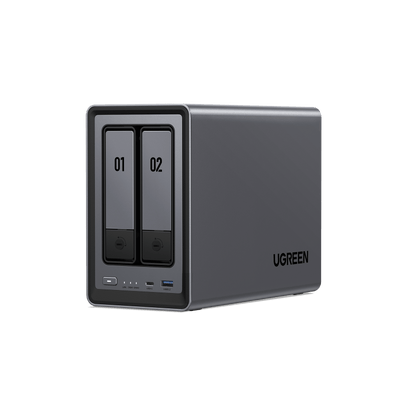How Much Does a NAS Cost in 2025?
Thinking about getting a NAS but unsure about the price tag? Whether you’re looking to organize personal files or streamline data management for your business, a NAS device can be a game-changer. But with so many options available, the cost can vary widely. Let’s break down the factors that determine NAS pricing so you can choose the best one for your needs without overspending.

What Can NAS Do for You?
A Network-Attached Storage (NAS) device is a powerful and versatile solution for anyone who needs centralized data storage with easy access across multiple devices. Whether you’re a home user, small business owner, or part of a larger organization, a NAS can simplify data management and enhance productivity. NAS can:
- Keep all your files, documents, and media in one location, easily accessible from any device connected to your network. Set up automatic backups for all your devices to prevent data loss, ensuring your important files are always safe.
- Access your data from anywhere, whether you’re at home, in the office, or traveling. Most NAS systems provide cloud-based services for remote file access.
- Stream music, movies, and videos to devices like smart TVs, game consoles, or smartphones, making it a perfect hub for entertainment.
- Share files with multiple users easily, ideal for home offices or small teams that need to collaborate on projects.
- With features like built-in RAID support and encryption options, a NAS can keep your data secure from hardware failure or unauthorized access.
- Expand your storage capacity as needed by adding additional hard drives, making NAS a long-term solution for growing storage needs.
NAS devices are incredibly versatile, but you may be wondering how much they cost. To learn more about what NAS is and how it can improve your data storage, check out this easy-to-follow guide. Next, we’ll break down the costs and share the best NAS options for 2025.
Factors Affecting Cost
There are the primary elements that determine NAS pricing, integrated naturally without referencing specific products repeatedly:
1. Number of Drive Bays
The number of drive bays in a NAS directly impacts how much storage it can hold and how easily it can be expanded. If you're choosing between a 2-bay or 4-bay NAS for home or media storage, this guide provides a simple comparison to help you decide. More drive bays mean more storage options but also higher costs. Smaller NAS systems with 2 or 4 bays are ideal for home users or small offices, while larger systems with 6 to 8 bays are better suited for businesses needing more storage and scalability.
2. Processor Performance
The CPU in a NAS plays a critical role in data processing and multitasking. A more powerful processor can handle more users, higher workloads, and faster data transfers, making it essential for businesses or power users who need quick access to large files or need to run multiple applications simultaneously. Entry-level NAS devices with simpler processors tend to be more affordable, while those with more robust processors, like Intel Core i5 or Ultra, push the price up significantly due to their ability to support demanding tasks.

3. Memory Capacity
RAM is a vital factor in determining how smoothly a NAS operates under heavy use. Larger memory allows the system to process multiple tasks faster and handle more data concurrently. For instance, a NAS with 16GB of RAM will perform more efficiently than one with just 4GB, especially when dealing with multiple applications or large datasets. The ability to expand memory in higher-end models adds flexibility but also increases the price.
4. Network Interface
Network ports are another significant price determinant. Devices with faster networking capabilities, such as 10GbE (Gigabit Ethernet), offer much higher data transfer speeds than standard 1GbE or 2.5GbE ports. Businesses or users working with large media files, such as video editing or data-heavy applications, will benefit from these high-speed connections, which increase both performance and cost.

5. Extra Features
Features such as RAID support, SSD caching, and hot-swappable drives can all raise the price. RAID configurations (such as RAID 1 or RAID 5) provide redundancy, improving data security by ensuring that data is not lost if a drive fails. SSD cache support accelerates access to frequently used data, while hot-swappable drive bays allow drives to be replaced without shutting down the system, minimizing downtime.
These features, while adding value, are often present in more advanced NAS models, leading to higher costs. For example, a NAS that offers multiple RAID levels, the ability to add SSDs for caching, and 10GbE ports will naturally cost more than a basic model with fewer features.
How Much Does a NAS Cost?
The price range for NAS devices typically falls into the following categories:
| NAS Category | Price Range | Features |
|---|---|---|
| Entry-Level (Home/Home Office/Small Office) | $150 to $300 | 1–4 drive bays, basic file storage, backups, and media streaming. |
| Mid-Range (Small Business/Power Users) | $300 to $600 | 4–8 drive bays, better processors, more storage, and advanced features. |
| High-End (Enterprise/Professional) | $600 to $2000+ | 8+ drive bays, powerful processors, enterprise-grade features, and high-speed data access. |
Best NAS for the Money in 2025
Want a premium NAS at a reasonable cost? Look no further than UGREEN. The UGREEN NASync DXP2800 offers an excellent balance between price and performance, making it one of the best NAS for budget-conscious users who still need reliable and efficient storage.
{{UGPRODUCT}}
You can check out the following highlights that make the UGREEN NASync DXP2800 the best NAS for the money of 2025:
- Affordable Price. At just $314.99, the DXP2800 provides excellent value, especially compared to similar NAS devices in its class.
- 2 SATA Drive Bays & 2 M.2 NVMe slots. Ideal for personal or small office use, supporting up to 64TB of storage with two 24TB HDDs and two 8TB M.2 SSDs.
- Intel N100 Processor. Equipped with a solid Intel N100 processor, providing efficient performance for everyday tasks like file storage, backup, and media streaming.
- Expandable Memory. 16GB RAM expansion support ensures smooth operation, even with moderate multitasking or heavier workloads.
- 2.5GbE Network Port. Provides a 2.5GbE network interface for faster data transfers than standard 1GbE, improving performance for most home or small business users.
- RAID Support. Offers multiple RAID configurations, allowing you to optimize performance and redundancy for your specific needs.
The Bottom Line
From budget-friendly options for home use to high-end models designed for businesses, there’s a NAS out there for every need and budget. For those looking for the best value out of a NAS, the UGREEN NASync DXP2800 is the best of 2025, balancing affordability and powerful features. With the DXP2800, you can take control of your data storage while keeping costs in check.




